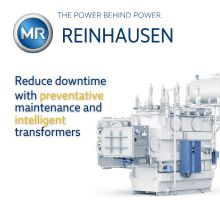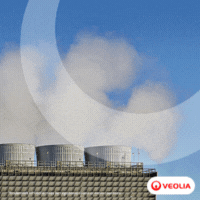Algoma Steel Reports Annual Results
02/08/2007 -
Feb. 8, 2007 — Algoma Steel Inc. reported net income of $50.4 million on sales of $418.4 million for the fourth quarter, and net income of $221.8 million on sales of $1.94 billion for the full year ended Dec. 31, 2006. Results are unaudited.
Fourth Quarter Results—The $50.4 million net income ($1.57 per diluted common share) compares to net income of $59.5 million in the third quarter and $55.0 million in the fourth quarter of 2005. EBITDA was $64.2 million compared to $112.3 million in the third quarter and $77.6 million in the fourth quarter of 2005. The decrease from the third quarter was due mainly to lower volumes (which declined 88,000 tons or 14%), and lower average steel prices that declined $53 per ton. Cash and short-term investments decreased by $34.2 million, primarily due to an additional $85.0 million of pension funding in the quarter.
Sales of $418.4 million were $98.5 million lower than the previous quarter and $59.2 million lower than the comparable period in 2005. The decrease from the previous quarter and the fourth quarter of 2005 was the result of lower average selling prices and lower shipments. Steel prices averaged $721 per ton as compared to $774 per ton in the third quarter and $751 per ton in the fourth quarter of 2005. Steel shipments totaled 534,200 tons, 88,200 tons lower than the previous quarter and 48,300 tons lower than the fourth quarter of 2005.
Abnormally high customer inventory levels and continued high levels of imports impacted fourth quarter performance. In addition, the company implemented the first phase of its new SAP Enterprise Resource Planning System late in the fourth quarter and, typical with the commissioning of a system of this complexity, experienced start-up issues that impacted shipping capabilities. The company expects to recover these delayed shipments in the first quarter of 2007.
EBITDA was $64.2 million compared to EBITDA of $112.3 million for the previous quarter and $77.6 million for the fourth quarter of 2005. The decline from the previous quarter was mainly attributable to lower selling prices, which declined $53 or 6.8%, and lower shipments which declined 88,200 tons or 14.2%. The decline from the comparable quarter in 2005 was also mainly due to lower selling prices and lower shipments, partially offset by lower manufacturing costs resulting primarily from lower natural gas and iron ore costs, offset by higher coal and employment costs.
Coke sales of 10,591 tons contributed $2.2 million to EBITDA, versus coke sales of 10,500 tons in the third quarter that contributed $2.6 million to EBITDA and coke sales of 27,200 tons in the fourth quarter of 2005 that contributed $7.9 million to EBITDA.
Approximately 20,000 tons of finished goods produced from purchased slabs were sold in the fourth quarter and these additional sales generated approximately an additional $0.1 million of operating income. This compares to approximately 70,000 tons of finished goods produced from purchased slabs that were sold in the third quarter generating approximately $4.4 million of operating income. Raw steel production totaled 651,000 tons versus 662,000 tons for the previous quarter and 671,000 tons for the fourth quarter of 2005.
Capital expenditures totaled $27.0 million, compared to $17.2 million in the fourth quarter of 2005. Expenditures in the fourth quarter of 2006 included $11.4 million of payments and deposits for equipment and materials associated with the partial reline of the blast furnace scheduled for July 2007. There were no financing activities in the fourth quarter of 2006, while financing activities in the fourth quarter of 2005 included $8.1 million for the purchase and cancellation of shares pursuant to a normal course issuer bid.
Full Year Results—The $221.8 million net income compares to net income of $239.6 million in 2005 and $343.8 million in 2004. The decrease in net income from 2005 was primarily due to lower average steel pricing for the year and lower coke shipments. Earnings per share on a basic and diluted basis were $6.10 and $6.06, respectively, as compared to $6.04 and $6.00 in 2005, and $9.35 and $8.83 in 2004. (In addition to changes in earnings over these periods, earnings per share reflect the reduction in shares outstanding due to share buybacks in 2005 and 2006. The weighted average diluted shares outstanding were 36.6 million in 2006 as compared to 39.9 million in 2005.)
Sales totaled $1.94 billion on steel shipments of 2.424 million tons as compared to 2005 sales of $1.92 billion on steel shipments of 2.283 million tons. Pricing for sheet products was fairly strong for the first nine months (averaging $672 per ton) before weakening in the fourth quarter to $624 per ton as a result of high service center inventory levels, increased imports and weaker economic conditions. Pricing for plate products remained fairly strong throughout 2006 averaging $1,074 per ton, but it was approximately 11% lower than the $1,207 per ton achieved in 2005. Overall, the average realized price for steel declined 3.7% compared to 2005, primarily due to very strong pricing in the first half of 2005.
The mix between sheet and plate products shifted slightly with plate products accounting for 20.8% of total shipments in 2006 as compared to 19.8% in 2005. (Sheet products include hot-rolled and pickled coils, cut-to-length coils, cold-rolled coils and first-stage blanks.) Total shipments of sheet products were up 4.9%. (Plate products include as-rolled and heat-treated plate, and welded wide flange beams.) Shipments of plate products increased 11.5% over 2005 as the company took advantage of the continuing strength in the plate market. Overall shipments increased 141,000 tons (6.2%) versus last year mainly due to higher production levels and relatively strong steel markets.
Non-steel sales were $43.3 million in 2006 as compared to $73.0 million in 2005. Non-steel sales include sales of various by-products generated in the manufacturing process. The decline in sales from 2005 relates primarily to a reduction of coke sales that totaled $13.6 million in 2006 as compared to $41.9 million in 2005.
During the year the company focused on selling more products with characteristics different from base sheet and plate products in order to improve its competitive position and improve margins. Total sales of these differentiated products represented 40% of total steel shipments as compared to 38% in 2005. Differentiated product sales were 42% in the fourth quarter of 2006 indicating continued progress on this initiative.
EBITDA totaled $381.1 million compared to $417.3 million in 2005. The primary reasons for the decline were lower average steel prices in 2006 and lower coke shipments. In 2005, coke shipments totaled 93,100 tons, contributing approximately $26.4 million to EBITDA, while in 2006 coke shipments totaled 32,000 tons and contributed approximately $7.8 million to EBITDA.
Approximately 165,000 tons of finished goods produced from purchased slabs were sold generating approximately $10.5 million of operating income.
Raw Materials Costs—Raw materials represented 51% of costs for steel products in 2006 (as compared to 47% in 2005). Raw materials included coal, ore, purchased coke, purchased scrap, purchased slabs, limestone and alloys.
During the year, the company shipped products manufactured from purchased slabs totaling 165,000 tons and representing 6% of costs for steel products. In 2005, the company shipped 5,000 tons of products manufactured from purchased slabs, representing less than 1% of costs for steel products. Accordingly, total raw material costs, inclusive of purchased slabs, represented 51% of costs for steel products in 2006 as compared to 47% in 2005. (The cost per ton of purchased slabs is greater than the cost per ton of internally manufactured steel.) The majority of Algoma's raw material purchases are priced in U.S. dollars and, as a result, costs benefited from the relative overall strengthening of the Canadian dollar.
Algoma obtains its coal requirements mainly through three suppliers with approximately 66% of the coal held in a consignment inventory in Sault Ste. Marie. Coal consumption in 2006 totaled $150.9 million (1.46 million tons dry basis), an increase of $12.1 million from last year's total of $138.8 million (1.43 million tons dry basis). The increase in cost was primarily due to an increase in the cost of certain types of coal and a change in the mix of coal used, while the increase in consumption quantity was primarily due to production increases. The company produced 1,009,300 tons of coke during 2006 as compared to 995,200 tons in 2005. Net of furnace coke sales, coal costs attributed to steel products totaled $146.3 million in 2006 as compared to $125.9 million in 2005.
Algoma has an exclusive supply agreement with Cleveland-Cliffs Inc. for the supply of iron ore with 10 years remaining in the 15-year agreement. Prices under the supply agreement, denominated in U.S. dollars, declined approximately 3.25% in 2006. Consumption of iron ore in 2006 totaled $312 million (3.9 million tons), an increase of 2% from 2005 in which Algoma consumed $306 million (3.8 million tons) of iron ore. The impact of the decrease in unit costs was delayed by the consumption of opening inventories valued at 2005 pricing which was consumed by the end of the second quarter. Production of hot metal increased 4% or approximately 100,000 tons from last year.
Consumption of alloys totaled $104 million as compared to $111 million in 2005. The 6% decrease was attributable to decreases in unit prices for certain alloys, offset by higher production levels.
Algoma consumed 158,500 tons of purchased scrap in 2006 at a total cost of $35 million. This compares to consumption of 174,500 tons of purchased scrap in 2005 at a total cost of $42 million. Algoma consumes approximately 640,000 tons of scrap annually with most of its scrap requirements generated from internal sources. The decrease in consumption of purchased scrap in 2006 was mainly due to a reduction in the overall consumption of scrap that resulted from improved liquid steel production resulting in the requirement for less scrap in the manufacturing process.
Consumption of purchased coke totaled 56,500 tons at a cost of $12 million as compared to 50,500 tons in 2005 at a cost of $17 million. The purchases were made to ensure adequate supply for internal consumption and to ensure that coke sales could be completed. Agreements were in place during 2006 for the sale of coke at favorable prices relative to the spot market.
Total energy costs declined in 2006 by 23% mainly due to a decline in the cost of natural gas. The average unit cost of natural gas decreased 20% from 2005 and natural gas accounted for approximately 59% of the company's total energy costs in 2006 compared to 69% in 2005. Algoma can maximize coke available for sale by adjusting the fuel mix in the blast furnace, displacing coke consumption for natural gas. When the profits that can be realized on the sale of coke exceed the fuel-cost penalty at the blast furnace, the company will operate on a high natural gas fuel mix to maximize coke production available for sale. These variables are monitored and adjusted regularly throughout the year. Total natural gas costs were $106 million in 2006 compared to $161 million in 2005.
The cost of purchased electricity totaled $42 million in 2006 as compared to $41 million in 2005. Total consumption of purchased electricity was up 8.1% whereas unit costs decreased 3.7%. The increase in consumption of purchased electricity was primarily due to a reduction in internally-generated electricity that resulted from a generator failure during the year.
Praxair Canada Inc. supplies oxygen, argon and nitrogen under a contract that had 8.5 years remaining at the end of December 2006. Algoma's total cost of oxygen in 2006 was down 11% from 2005 at $20 million, due to rate reductions and lower facility costs.
Gross Margin—Gross margin on steel products was $443.8 million ($183 per ton) as compared to $461.3 million ($202 per ton) in 2005, representing a decrease of $17.5 million ($19 per ton). Gross margin on non-steel sales was $7.7 million in 2006 as compared to $25.8 million in 2005, representing a decrease of $18.1 million (70.3%) as a result of significantly lower coke sales in 2006 as compared to 2005.
Outlook—While the company is anticipating continued volume growth in 2007 as it continues to execute its growth plans, actual volumes attained in 2007 will be impacted by several factors including:
- The actual impact that blast furnace downtime has on the production of steel and the ability of the company to have appropriate levels and grades of inventory to supply customer demand during the downtime.
- Levels of inventories held by service centers throughout the year.
- General economic conditions in Canada and the U.S., and the impact on demand of steel-intensive products and industries such as automotive, heavy machinery, housing and non-residential construction.
- Levels of imports from countries such as China, Brazil, India and Russia.
- The ability of the company to secure necessary amounts of purchased slabs at appropriate prices.
The company says there are early indications that show the declines in steel prices that occurred in the fourth quarter of 2006 have abated, and with continued decline in service center inventories in the first quarter of 2007 market tightness should support increased pricing taking affect in mid to late Q1. The sustainability of these increases and the likelihood of further increases will be dictated by industry and economic factors.
The company has not completed negotiations for 2007 iron ore unit prices, but they are expected to be in the range of 5% to 5.5% higher than 2006 pricing. The impact of higher 2007 pricing will likely not take full effect until the end of the first quarter given inventory levels at the end of the year that are at 2006 price levels. Iron ore volume is expected to be down by approximately 8% due to the scheduled partial blast furnace rebuild in July.
The company has concluded contractual arrangements respecting 100% of its coal requirements for 2007. Algoma estimates its 2007 contract coal costs per ton will be approximately 8% lower than 2006 coal contract costs. The decrease from 2006 is mitigated by several factors which include the effect of higher cost coal at previous contract pricing to be consumed in the first half of 2007 (the FIFO inventory effect) and the assumption that the current higher level of the Canadian dollar is maintained. Management cautions that actual coal costs are subject to many variables and could vary significantly from these estimates. These variables include the value of the Canadian dollar, shipment reliability against contracts, delivery costs, the mix of coal used, and coke-making production levels.
In 2006, approximately 66% of coal inventories were carried by Algoma's primary coal supplier until the point of consumption under a consignment arrangement. This arrangement will remain in place in 2007. The balance is purchased from other suppliers at the point of delivery of the coal to Algoma.
The company anticipates that rail and vessel freight costs will increase marginally, influenced by base price increases and fuel prices. No significant market price changes are anticipated for alloys. The cost of alloys used in production is influenced by product mix.
The company does not expect employment levels to change significantly from 2006 levels. Wage rates in 2007 will ultimately be influenced by the result of union contract negotiations. The company notes that the current labor contract expires on July 31, 2007.
The company plans on increasing the level of sales from purchased slabs in 2007 as a result of expected increases in volumes and to cover steel needs during the blast furnace downtime. The amount of total slabs purchased in 2007 will also be impacted by inventories maintained through the year. The cost of a purchased slab is higher than the cost of manufactured steel and, accordingly, increased levels of purchased slabs will impact the average cost of raw materials in cost of goods sold.
The company plans on shutting down its blast furnace in July 2007 for a period of 31 days to perform remedial work. Capital expenditures related to this outage are currently estimated at $41 million and related expenses are estimated at $12 million. The actual capital and expense outlays could vary significantly from these estimates due to the length of the outage, cost escalation, changes in scope, and other factors.
Capital expenditures are projected to increase to approximately $170.0 million in 2007 from $67.4 million in 2006. The increase is due, in part, to the effect of the blast furnace outage scheduled for July 2007, the cogeneration facility and the Business Systems Renewal Project.
The company holds a 10% revenue royalty on lands near Wawa, Ont., (the "Leadbetter Extension Property") on which Dianor Resources Inc. is conducting a diamond exploration program. Dianor has reported the occurrence of diamonds in the surface sampling and drilling that it has conducted to date. Algoma also owns lands abutting the Leadbetter Extension Property.


.png?mediaprotectionhash=3750102d6e35cf158ae995d2a880e68af6bba8e3c74cb3bcacc2f4a4a71af45a&width=220&height=200&ext=.png)
-(1)-Reinhausen-(1).jpg?lang=en-US&ext=.jpg)




-Cutsforth.png?width=100&height=200&mediaprotectionhash=4482cb5f76125ba3348ab8851ab91d4ab118b35e517c017615489ff39c41f1af&ext=.png)